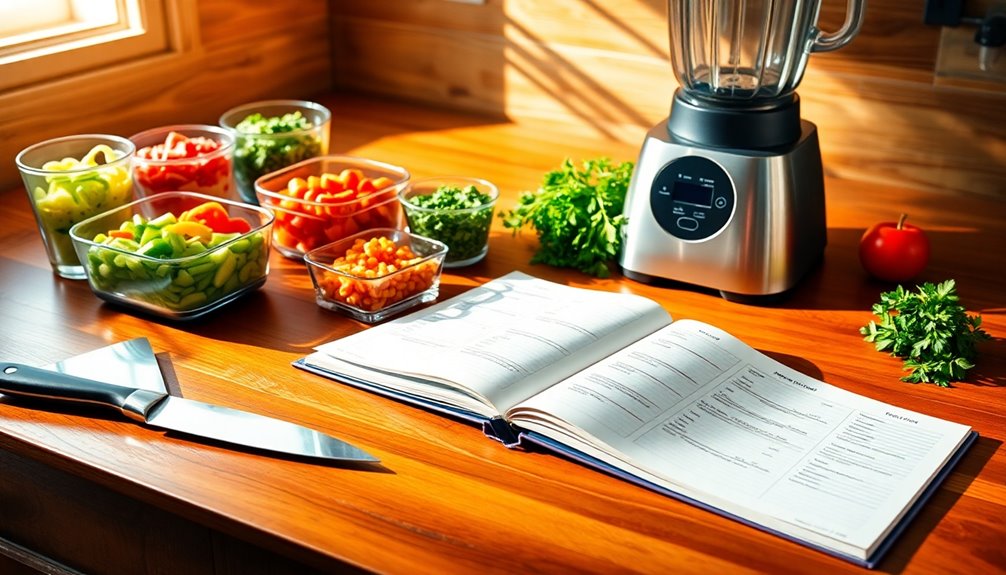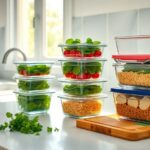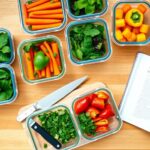To save time during meal prep, start by planning your weekly menu and making a categorized shopping list. Batch cooking grains, proteins, and vegetables can markedly reduce your cooking time. Use time-saving kitchen tools like slow cookers and food processors to streamline tasks. Prep ingredients ahead by chopping and storing them in labeled containers to grab easily. Consider freezing meals for later to guarantee you always have healthy options on hand. By organizing your workspace and embracing one-pot recipes, you'll simplify the process. Want to discover more clever strategies? There's plenty more to explore.
Key Takeaways
- Plan a weekly menu with family preferences to streamline shopping and cooking processes.
- Batch cook grains, proteins, and vegetables for quick assembly during meal prep.
- Utilize kitchen tools like food processors and slow cookers to save time on meal preparation.
- Pre-portion and label ingredients in containers for easy access and organization during cooking.
- Involve family members in meal prep by assigning roles to make it a collaborative, efficient task.
Plan Your Weekly Menu
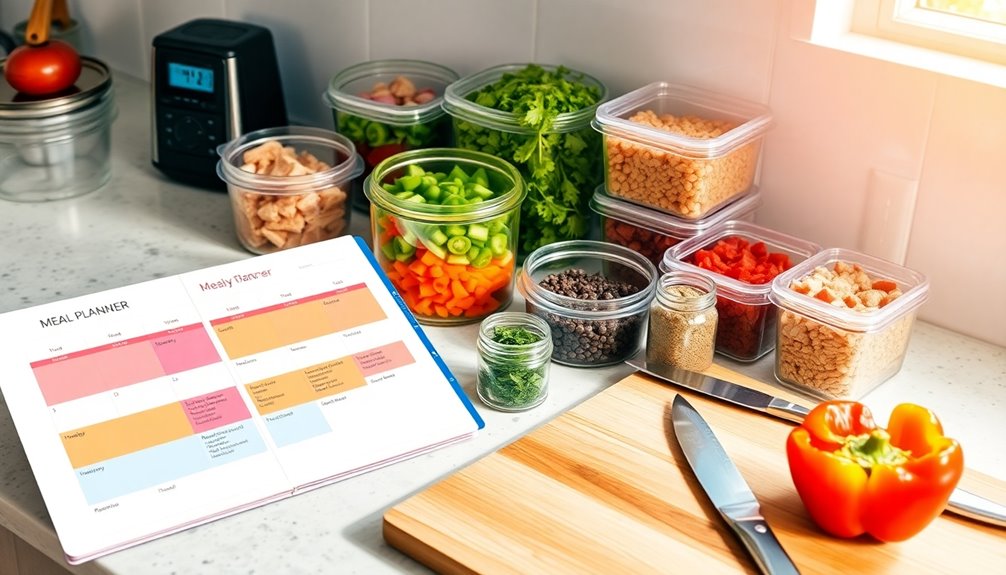
Planning your weekly menu is the cornerstone of efficient meal prep. By dedicating some time each week to this critical task, you set yourself up for success, reduce stress, and make mealtime more enjoyable. Start by considering your family's preferences and dietary needs, which fosters a sense of belonging and guarantees everyone looks forward to dinner.
One effective meal planning strategy is to choose a mix of recipes that balance variety and simplicity. Look for dishes that share ingredients, minimizing waste and saving you money. When selecting recipes, keep them organized in a digital or physical format, so you can easily reference them each week. Creating a categorized recipe binder or using an app can help streamline your process, making it easier to find inspiration when you're in a time crunch.
Don't forget to think about batch cooking! Preparing larger portions of meals that freeze well lets you enjoy home-cooked flavors on busy days. It's also a great way to get your family involved—assign tasks like chopping vegetables or stirring pots. This not only makes the process quicker but also strengthens connections through shared experiences.
Lastly, consider theme nights—like Meatless Mondays or Taco Tuesdays—to spark creativity and make planning a breeze. By implementing these meal planning strategies and keeping your recipes organized, you'll cultivate a smoother kitchen routine that nourishes both body and spirit.
Make a Shopping List
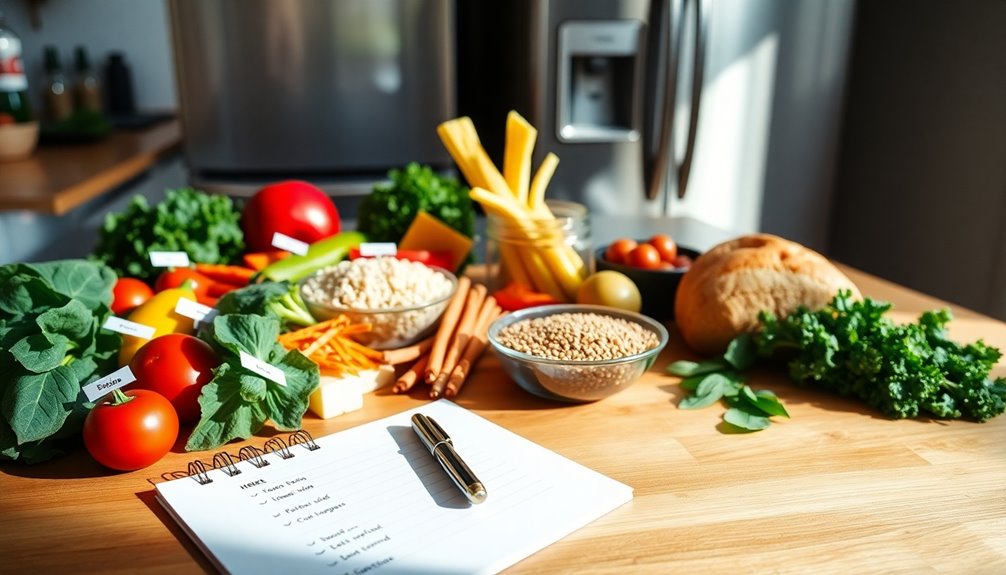
Once you've mapped out your weekly menu, creating a shopping list becomes essential for staying organized and making sure you have all the ingredients on hand. A well-structured list not only streamlines your shopping experience but also helps you stick to budget-friendly meal ideas. When you know exactly what you need, you're less likely to make impulse purchases that can inflate your grocery bill.
Start by categorizing your list based on the sections of the grocery store—produce, dairy, grains, and proteins. This method acts as a meal prep hack, saving you time and energy as you navigate the aisles. As you compile your ingredients, refer back to your menu to confirm you haven't overlooked any essential items. If you're trying to stick to a budget, consider planning meals that share ingredients, allowing you to buy in bulk and reduce waste.
Don't forget to check your pantry and fridge before heading out. You might already have staples that can serve as the foundation for your budget-friendly meal ideas. For example, if you've got rice and beans, they can easily become the base for a variety of dishes throughout the week.
Lastly, consider using grocery apps to create your shopping list digitally. These tools often allow you to compare prices and find coupons, making your shopping experience efficient and cost-effective. With a solid shopping list in hand, you'll set yourself up for a successful week of meal prep! Incorporating plant-based ingredients into your shopping list can further enhance your health and nutrition.
Batch Cook Ingredients
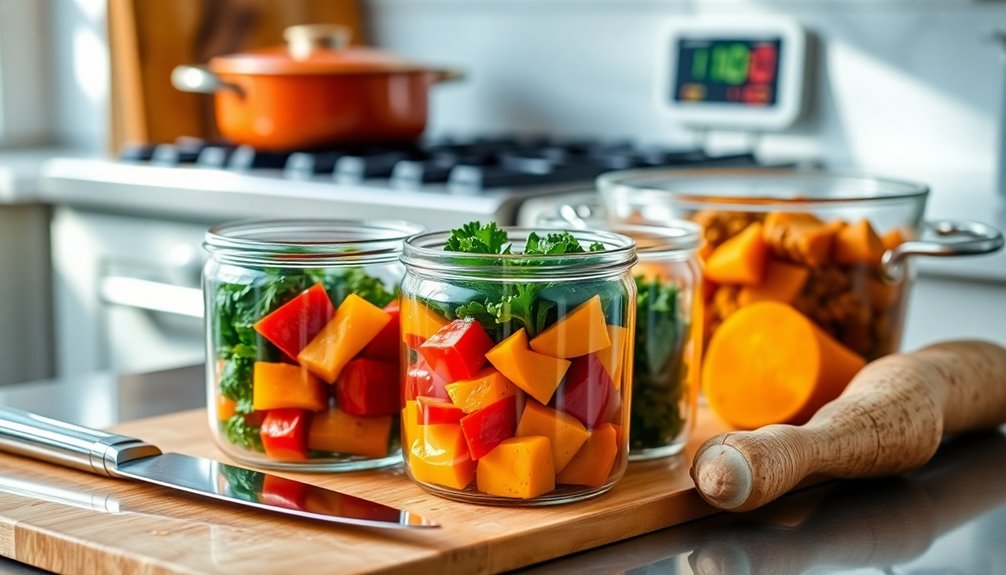
How can you make the most of your meal prep time? One effective strategy is to batch cook ingredients. This means preparing large quantities of versatile items that can be used in various meals throughout the week. By doing this, you'll save time, reduce food waste, and simplify your cooking process.
Start by selecting a few staple ingredients—think grains, proteins, and vegetables. Cook a big batch of quinoa, brown rice, or whole grains, and roast or steam a variety of vegetables. You can also grill or bake chicken, tofu, or legumes. Doing this allows you to mix and match throughout the week, creating different meals without the daily hassle.
When batch cooking, proper ingredient storage is essential. Invest in good quality airtight containers to keep your food fresh. Label each container with the date and contents to make sure you stay organized and aware of what you have on hand. This practice not only makes it easier to find ingredients but also helps with portion control. By knowing how much you have, you can plan your meals more effectively and avoid overeating.
Lastly, remember to freeze any extras. Freezing is a great way to extend the life of your cooked ingredients and can save you on days when you're short on time. Additionally, consider incorporating a custom keto diet plan into your meal prep strategy to ensure your meals align with your nutritional goals. With these steps, you'll streamline your meal prep process and enjoy healthy, homemade meals all week long.
Use Time-Saving Tools
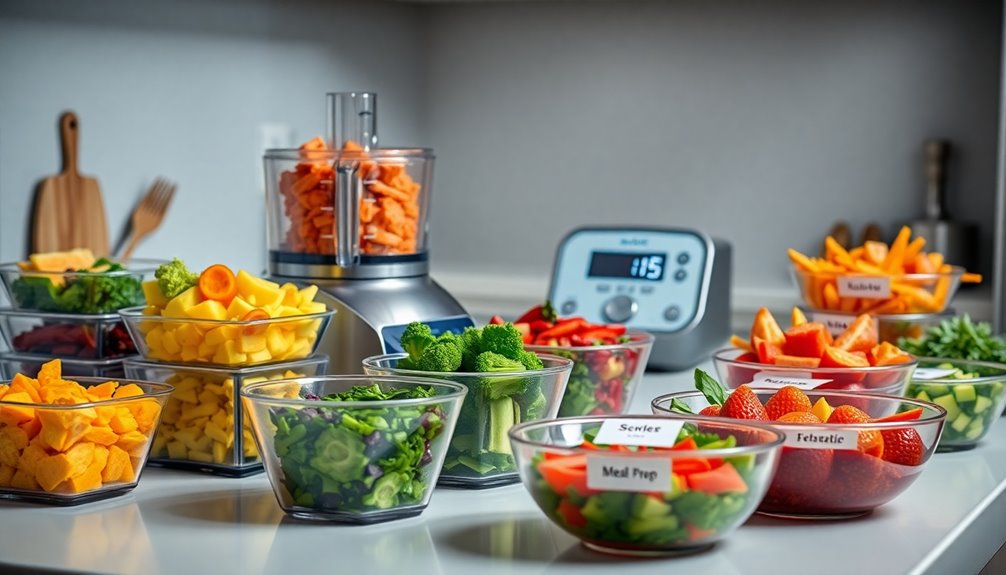
Using the right tools can greatly enhance your meal prep efficiency. Investing in a few essential kitchen gadgets can save you time and make your meal prepping techniques more streamlined.
For instance, a high-quality food processor can chop vegetables in seconds, while a slow cooker allows you to set it and forget it, freeing you up for other tasks.
Consider adding a reliable set of measuring cups and spoons to your arsenal. Accurate measurements can help you follow recipes closely, reducing the likelihood of mistakes that require redoing your work.
A digital kitchen scale is also beneficial for precise ingredient portions, especially if you're following specific dietary plans.
Don't underestimate the power of a good set of knives. Sharp knives can notably speed up your chopping and slicing, making prep feel less like a chore. Additionally, investing in multi-functional gadgets, like an immersion blender, can eliminate the need for multiple appliances, saving both space and time.
To take your meal prepping techniques to the next level, explore tools like silicone baking mats, which streamline cleanup and prevent sticking.
Lastly, consider using airtight containers for storing your prepped ingredients. They not only keep food fresh longer but also keep your kitchen organized, making it easier to grab what you need when it's time to cook. Additionally, incorporating tools like mini bands into your fitness routine can help tighten and tone muscles, enhancing your overall wellness alongside your meal prep efforts.
Prep Ingredients in Advance
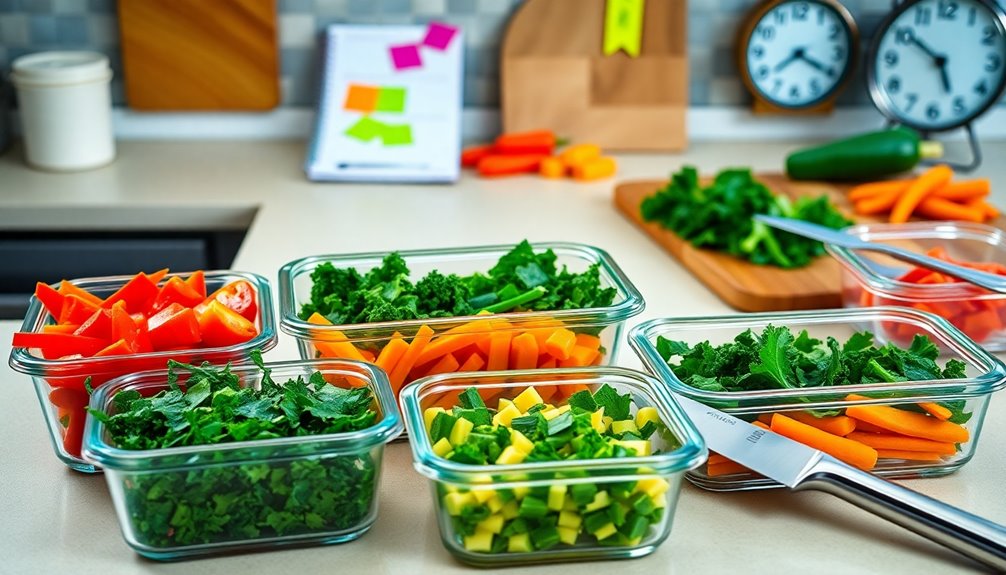
After equipping your kitchen with efficient tools, the next step is to prep your ingredients in advance. This simple practice can markedly reduce your cooking time during the week and make meal planning less stressful. By prepping ahead, you also enhance your ingredient storage, ensuring freshness and maximizing flavor. Additionally, incorporating healthy fat loss into your meal prep can lead to better energy levels throughout the week.
Here are four practical steps to get you started:
- Chop and Portion: Spend a few hours cutting vegetables, marinating proteins, or portioning grains. Store them in clear, labeled containers to easily identify what's what.
- Create a Meal Rotation: Plan a weekly menu that rotates meals, ensuring you use all your prepped ingredients efficiently. This not only minimizes waste but also keeps your meals exciting.
- Batch Cook Staples: Cook large quantities of staple items—such as rice, quinoa, or beans—that you can use in various meals throughout the week. This saves you time and allows for versatile recipe options.
- Pre-assemble Meals: If you have a busy week ahead, consider assembling full meals in advance and storing them in the fridge. Just heat them up, and you're good to go!
Freeze Meals for Later
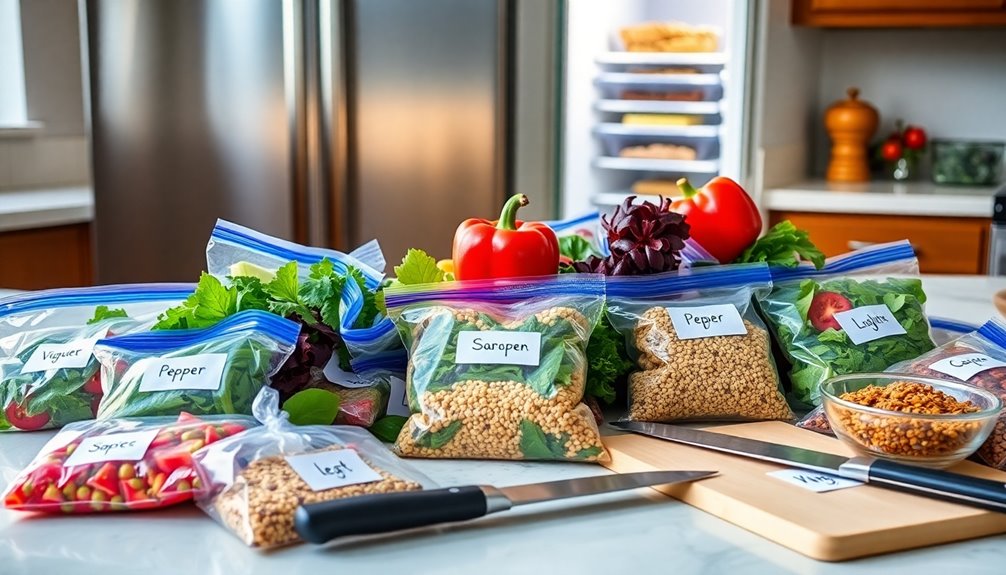
Freezing meals for later is a game-changer when it comes to efficient meal prep. By mastering effective meal storage, you can guarantee you always have nutritious options ready to go, saving you time and stress during busy days. When you batch-cook meals and freeze them, you can enjoy home-cooked goodness without the hassle of daily cooking.
Start by choosing recipes that freeze well, like soups, stews, casseroles, or even cooked grains. Proper freezing techniques are crucial to preserve flavor and texture. Use airtight containers or heavy-duty freezer bags, removing as much air as possible to prevent freezer burn. Label each container with the meal name and date to keep track of what you have on hand. Additionally, incorporating protein-packed vegan smoothies into your meal prep can provide an easy and nutritious option for breakfast or snacks.
When you're ready to enjoy your frozen meal, simply transfer it to the fridge the night before to thaw safely. If you're short on time, you can reheat directly from frozen, but it may take longer to cook. Always make sure to heat your meals thoroughly to guarantee food safety.
Organize Your Workspace
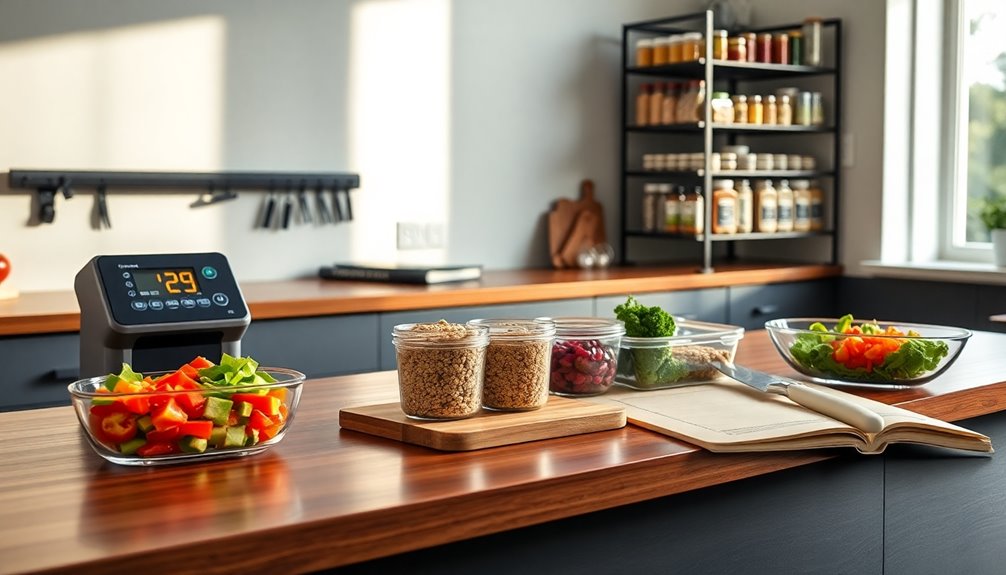
To make meal prep more efficient, organizing your workspace is essential. A well-organized kitchen not only streamlines your cooking process but also makes you feel more at home in your space. Here are four practical steps to help you get started:
- Clear counters: Start by removing any items that don't belong in your cooking area. Clear off your countertops to create a tidy and welcoming space. A clutter-free environment reduces distractions and allows you to focus on your meal prep.
- Use storage containers: Invest in storage containers to keep your ingredients and tools organized. Label them for easy access, ensuring you know where everything is at a glance. This way, you'll spend less time searching for items and more time cooking.
- Establish designated zones: Designate specific areas for prep, cooking, and cleaning. This helps you move smoothly between tasks and keeps your workflow efficient. For instance, keep cutting boards and knives near the prep area and pots and pans close to the stove.
- Keep essentials within easy reach: Make sure your most-used tools, spices, and ingredients are within arm's reach. When everything is organized and accessible, you'll find that the cooking process becomes faster and less stressful. Additionally, having a well-organized kitchen can enhance your experience of creating delicious, easy-to-make recipes, making meal prep more enjoyable.
Embrace One-Pot Recipes
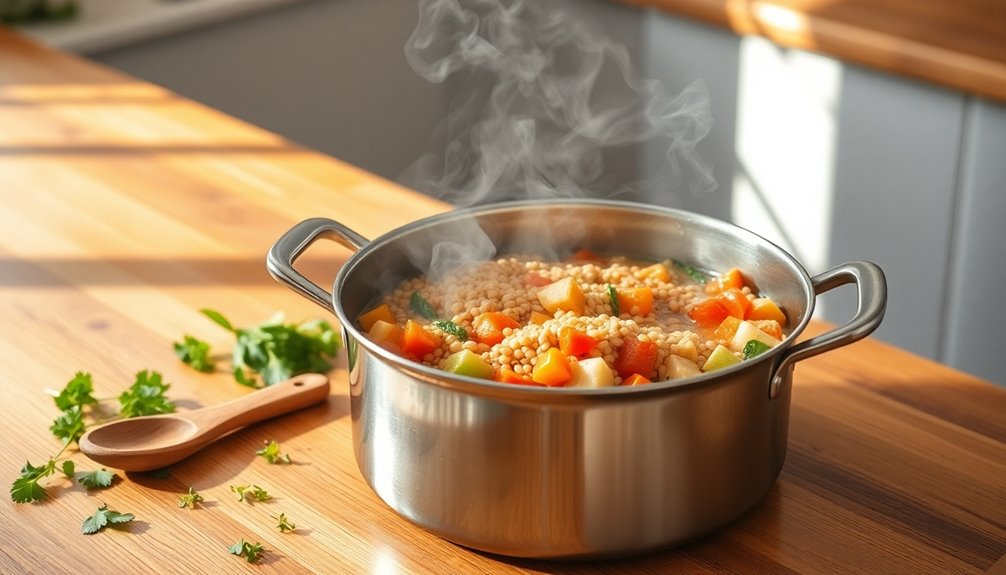
One-pot recipes are a game-changer when it comes to efficient meal prep. They simplify your cooking process by minimizing the number of dishes you use, allowing you to focus on creating delicious meals without the overwhelming cleanup. By embracing one-pot meals, you can explore various flavor combinations that not only enhance the taste but also make your cooking experience more enjoyable.
These recipes often utilize diverse cooking techniques, such as sautéing, simmering, and baking, all within the same pot. This method can intensify flavors as ingredients meld together, creating a more harmonious dish. Think about a hearty chicken and rice dish where spices, herbs, and vegetables all cook together; this not only saves time but also results in a meal that feels complete and satisfying.
Moreover, one-pot recipes are versatile and adaptable to your preferences. You can easily swap ingredients based on what you have at home or what's in season, allowing for creativity while sticking to your meal prep goals. Whether you're preparing a comforting stew, a vibrant stir-fry, or a wholesome casserole, the possibilities are endless.
Incorporating one-pot recipes into your meal prep routine can lead to less stress in the kitchen and more time for what matters most. You'll feel a sense of accomplishment as you serve up flavorful, nutritious meals without the hassle, and you'll likely find your family and friends asking for seconds. Additionally, following a natural cycle of consumption can help you maintain a lean and healthy body while enjoying these delicious meals.
Involve the Family
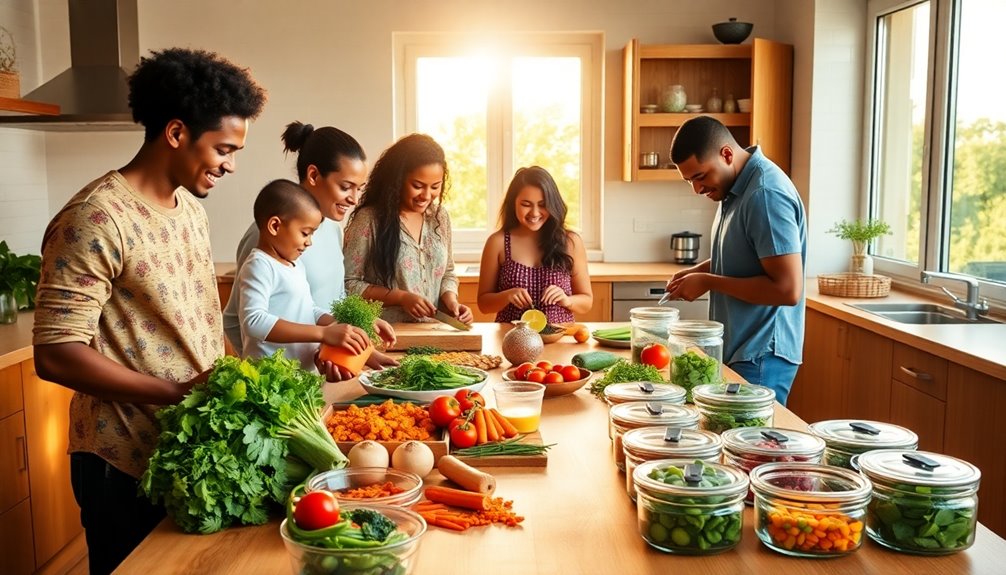
Involving the family in meal prep not only makes the process more enjoyable but also promotes teamwork and bonding. When everyone pitches in, you create a sense of belonging and shared responsibility, making meal prep a fun, collective experience. Here are a few practical ways to get your family involved:
- Assign Roles: Give each family member a specific task such as chopping vegetables, measuring ingredients, or stirring pots. This way, everyone feels included and vital to the meal-making process.
- Plan Together: Sit down as a family to decide on the week's meals. Allowing everyone to contribute their ideas ensures that meals cater to everyone's tastes and preferences, strengthening family bonding.
- Create a Cooking Playlist: Music can enhance the cooking experience. Create a fun playlist together that everyone enjoys, setting a lively atmosphere while you prep meals.
- Make It Educational: Use this time to teach kids about nutrition, cooking techniques, or even cultural recipes. Involving them in learning fosters curiosity and responsibility around food. Additionally, discussing the importance of managing underlying conditions through healthy eating can promote overall wellness for the entire family.
Frequently Asked Questions
How Can I Reduce Food Waste During Meal Prep?
To reduce food waste during meal prep, focus on preventing spoilage by storing items properly and using airtight containers.
You should also practice portion control; measure out what you need to avoid cooking too much.
By planning meals ahead and utilizing leftovers creatively, you can guarantee that food doesn't go to waste.
Engaging in these habits not only helps the environment, but it also saves you money and makes meal prep more enjoyable.
What Are Some Quick Breakfast Ideas for Busy Mornings?
When mornings get busy, quick breakfast ideas can make all the difference. Try smoothie bowls, packed with fruits and greens, as they're not only nutritious but also customizable to your taste. You can whip them up in minutes!
Another great option is egg muffins; just mix eggs with your favorite veggies, bake them in advance, and grab one on your way out. Both options are delicious, filling, and perfect for your hectic schedule.
How Do I Choose the Right Containers for Meal Storage?
When you're choosing the right containers for meal storage, focus on container durability and portion control.
Look for BPA-free plastic or glass containers that can withstand temperature changes.
Opt for various sizes to help you manage portions effectively, ensuring you don't overeat or waste food.
Having the right containers makes meal prep feel more organized and encourages you to stick to your healthy eating goals.
You'll feel more accomplished and connected to your meals.
Can I Meal Prep for Specific Dietary Restrictions?
Absolutely, you can meal prep for specific dietary restrictions! Start by identifying your needs, like vegan options or gluten-free alternatives. Plan meals around these requirements, using whole foods and fresh ingredients. Research recipes that cater to your restrictions, ensuring you enjoy diverse flavors.
Batch cooking can help you prepare multiple meals at once, making it easier to stick to your diet. Staying organized and informed makes meal prep a seamless part of your routine!
What Are the Best Ways to Reheat Frozen Meals?
Isn't it wonderful to have frozen meals ready when you're hungry? To reheat them, you've got options.
For quick microwave tips, use a covered dish and stir halfway through to guarantee even heating.
If you prefer oven options, preheat to 350°F, cover with foil, and heat for about 20-30 minutes.
Both methods will have your meal hot and delicious, so you can enjoy it with friends or family without the hassle!
Conclusion
By embracing these meal prep strategies, you're not just saving time—you're crafting a nourishing tapestry of health for you and your family. Each organized step transforms the chaos of daily cooking into a harmonious rhythm, allowing you to savor life's moments instead of rushing through them. Like a well-tended garden, these practices cultivate not just meals, but also connection and joy around the table. So grab your tools, roll up your sleeves, and watch your culinary landscape flourish.

